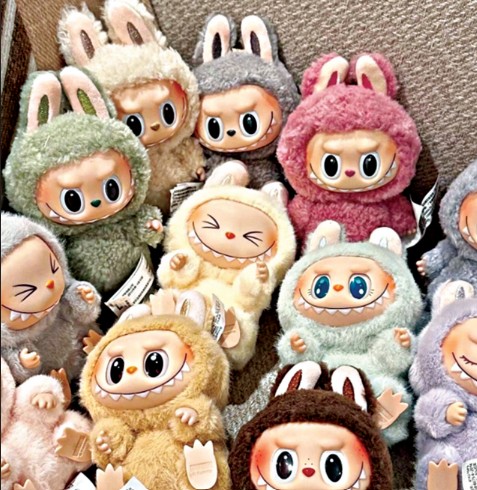trends, but today’s iteration is no longer about creativity or innovation. Instead, it’s become a performance of excess, repetition, and increasingly, absurdity. The current crown jewel of this chaotic carousel is the Labubu-strawberry cup. For the uninitiated, Labubu is a designer toy by Hong Kong brand POP MART, once adored for its mischievous aesthetic and collector appeal. Now, it’s being immortalized in gelatin, gold foil, and luxury fruit parfaits—all for the sake of virality. Common folks and celebrities alike, across the world including Olivia Attwood, Rihanna, Ananya Panday, Pashmina Roshan, and Sharvari Wagh to name a few have been carrying their Labubus.
At first glance, the mashup of Labubu figurines encased in edible gold and perched atop strawberry soft serve might seem like playful kitsch. But scroll deeper into TikTok or Instagram Reels, and a different picture emerges: a factory line of influencers racing to outdo each other, their videos eerily similar, voices echoing the same adjectives—‘LUXURIOUS’, ‘EXCLUSIVE’, ‘NEXT-LEVEL’.
“It stopped being about art or experience a long time ago,” says trend analyst Mira Khatri. “Now it’s just algorithmic bait. If it sparkles, squishes, or drips, it trends.”
Trends Turn Treadmills
This endless pursuit of the next viral hit has birthed a bizarre new genre of content: what some call ‘aesthetic extremism’. Whether it’s chocolate-covered Wagyu or a $50 coffee served in a diamond-cut glass, or a banana pudding matcha drink that’s a disaster to carry, creators are stuck in a loop of escalation.
The most telling symptom? The rapid burnout of ideas. What goes viral today is passé tomorrow. Content creators feel pressure to churn out increasingly elaborate spectacles that feel more like rituals than recipes.
In the process, trends lose their charm and audiences their sense of wonder. The creative spark that once drove virality has been replaced by a kind of content cultism—obsessive replication for views alone.
Mindless Cult Following
In late 2023, a video showing a Dubai-based chocolatier cracking open a shimmering, gold-dusted dessert sparked a wildfire of fascination. The world swooned over the spectacle: molten centres, branded boxes, and layers of indulgent extravagance. But what seemed like a charming moment of internet whimsy has since morphed into something far stranger—a vortex of viral mimicry where novelty is sacrificed at the altar of attention.
Brands are eager to capitalize on the chaos. What began as grassroots creativity has now been hijacked by marketing teams, who package and pre-sell viral aesthetics before they even trend. Slogans like “TikTok made me try it” are now stamped on storefronts, the irony lost on no one.
Clicks Over Craft
“It’s exhausting,” confessed Priya Mitra, (pastry chef). “You’re not making food anymore; you’re making content ‘about’ food. Half the time it doesn’t even taste good. It just looks expensive enough to get likes.”
As audiences become more discerning, some are pushing back. A growing cohort of viewers is turning to slower, more intentional creators who prioritize craft over clicks. But these remain exceptions in a landscape ruled by speed and spectacle.
Algorithm vs. Authenticity
The elephant in the room is the algorithm. Platforms like TikTok and Instagram reward virality with visibility, incentivizing creators to mimic whatever is currently performing well. This algorithmic pressure homogenizes content, flattening what could be a rich landscape of diverse ideas into a bland parade of golden chocolate shells and strawberry-stuffed figurines.
“The algorithm doesn’t care about creativity,” said Mira Khatri. “It cares about completion rate and replay value. That’s what’s fuelling this race to the absurd.”
In this environment, true innovation struggles to break through. The bizarre becomes banal, and the line between trend and parody grows increasingly blurry.
Real & Reel Time
As the internet continues to mutate in real time, one thing is clear: we’re at crossroads. The current model, driven by excess and imitation, is unsustainable. While viral trends
once brought joy, discovery, and shared curiosity, they now risk becoming cultural noise—disposable, forgettable, and ultimately meaningless.
But perhaps that very fatigue is the opening for something new. The pendulum may yet swing back toward authenticity, where quality, sincerity, and even
a little restraint reclaims centrestage. Until then, the 24k golden Labubu Strawberry Dubai Cup reigns—frozen in sugar, encased in foil, and worshipped in pixels.
Crazy Trend
Several celebrities like Rihana, Olivia Attwood, Ananya Panday, Pashmina Roshan, and Sharvari Wagh to name a few have been carrying their cute monster dolls (Labubus) everywhere.


